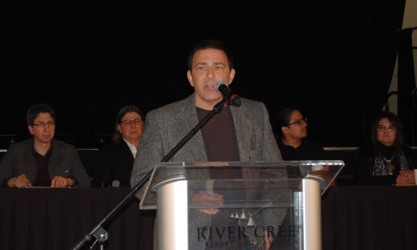Article Origin
Volume
Issue
Year
The fear of unexploded munitions has forced Enoch Cree Nation to immediately close its golf course and historic cultural grounds indefinitely.
The Alberta First Nation is the latest First Nation to find its land had been used for war exercises, says legal counsel for Enoch, Will Willier.
Reserve land was regularly used for training exercises in the First and Second World Wars and the Cold War.
“The federal lands that the (federal government) still had were where all the Indians were. The Department of National Defence is federal. They had to look at their federal lands. They asked for land back from Alberta to bomb unoccupied Crown lands, so the paper work was easier for them just to take it back,” he said. “It was common back then to just take back the Indian lands and use them.”
Willier points to Vernon, B.C. where unexploded devices killed a number of children. An active training area and five unexploded ordnance legacy sites are located in the Regional District of North Okanagan in south-central B.C., which includes the Okanagan Indian Band land. Willier said the band reached a settlement with the federal government.
He notes that there are two other test sites in Alberta, on the Tsuu T’ina First Nation, where artillery training took place, and the Cold Lake First Nation, where the Cold Lake weapons range exists.
A claim submitted to the Specific Claims Tribunal by the Enoch Cree Nation for the Yekau Lake area was accepted in June 2011. The claim area, which is a leased area established by the federal government in the 1940s to serve as a Commonwealth practise bombing site during the Second World War, was demarcated by the Department of National Defence. However, DND’s own records indicate that bombs fell outside the approved area and Enoch Cree Nation has determined that bombs fell outside three of those four boundaries.
In August 2013, the federal government stipulated that, for the claim to go ahead, Enoch Cree Nation had to accept that the leased land had been remediated and that the Nation be satisfied with the maximum payout of $150 million allowed under Specific Claims.
“But if we’re accepting the shape of the land that it is in, then we better know that, not based on their records, but based on our records,” said Willier.
After years of waiting for a full report from the federal government and getting only sections at a time, chief and council engaged Anvil GeoSpatial Corporation to undertake physical work of the area and an examination of government material provided and government material obtained under the Freedom of Information Act.
“Some very alarming findings have been brought to the attention of me and my council,” said Enoch Chief Ron Morin. “We are absolutely disgusted and angry… with these findings.”
Morin said that up until the band undertook its own analysis, they had been led to believe by the federal government that the site was used to drop 11.5 pound smoke bombs. He also said they were told 12,000 munitions were dropped, but council now estimates that number at 140,000 to 200,000.
“Our findings to date contradict the information that was made available to us (by the federal government). Based on that … I have to assume (the area) is potentially dangerous unless the government can basically demonstrate otherwise,” said Reg Letourneau, president of Anvil.
“Alarming” information came to light, he said, including two areas that “appeared to be the results of … bomb craters.” Also discovered was an unexploded practise round.
“It’s relatively harmless, but it’s symbolic in terms of what it represents. This is an artillery round. A Nation has been led to believe for almost 70 years that this was a Commonwealth air practise bombing range and no one had ever suggested it was an artillery range,” said Letourneau.
Based on its findings, Enoch Cree Nation is demanding that the federal government take action.
“We’re calling on the government of Canada to write full and complete truth about the activities that took place at the site, including disclosure about the number and type of munitions used and all related information,” said Morin.
The federal government is also being asked to supply funding to erect a fence around the area in question; provide safe drinking water until it can be determined if the leeching of munitions has contaminated the ground water; restore the land to its original natural state; and financially compensate for the loss of the lake, land, and all activities that cannot occur at the site. The closures will impact at least 50 employees at Indian Lake Golf Course and those within the Nation’s cultural department. Council will undertake a search for a new location for cultural activities to be carried out.
Morin said there is also concern that German and Japanese Prisoners of War, who were held in camps at the Enoch Cree Nation, died while in care. He said preliminary examination has found what could be burial sites or graves not far from the POW camps.
“We need to give proper homage, respect and diplomacy to those nations and do proper ceremony here for any of their loved ones that may have been lost,” he said.
Photo caption: Enoch Cree Nation Chief Ron Morin (far left) looks on as Reg Letourneau talks about what his company turned up through accessing government information and doing its own probing.
- 5192 views

